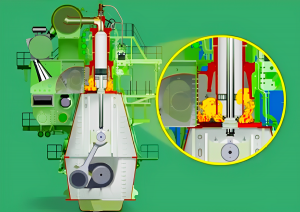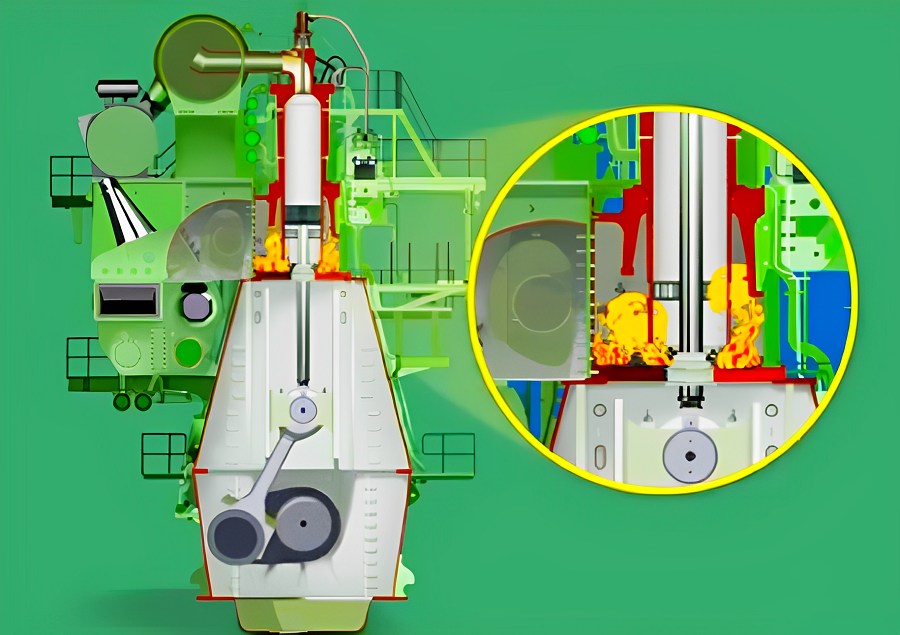
A scavenge fire on marine two-stroke diesel engines can occur when unburned oil and carbon, such as unburned fuel or cylinder lubricating oil, ignites in the scavenge spaces. This can be caused by a range of factors, including defective injectors, faulty fuel pump timing, incorrect fuel conditions, lack of scavenge air, partially choked exhaust, low compression, afterburning, operating the engine at overload conditions, defective piston rings, badly worn cylinder liner, or wrongly timed or excessive cylinder lubrication.
The oil buildup in the scavenge spaces can become carbonized by further heating and reach a condition where it can burn in the presence of air. The fire can be ignited by hot gases and burning particles from the blowpast of piston rings. Indications of a scavenge fire include loss of power, irregular engine running, high exhaust temperatures, smoke in the exhaust gas, high local temperature in scavenge trunk, surging of the turbocharger, and sparks and smoke from scavenge drains.
If a scavenge fire is detected, immediate actions should be taken to reduce engine speed, shut off fuel from the affected units, increase cylinder lubrication, and shut scavenge drains. A minor fire may burn out shortly, and the affected units should be run on reduced power until the scavenge trunking can be inspected and the cylinder and piston overhauled.
However, if the fire persists or there is a risk of it extending, the engine must be stopped, normal cooling maintained, and turning gear engaged to prevent seizure. Fire extinguishing mediums such as carbon dioxide, dry powder, or smothering steam should be applied through fittings in the scavenge trunk, and measures must be taken to prevent the fire from spreading. If necessary, cooling may be applied to the outer surfaces, but the scavenge trunk should never be opened while it is still hot, as this may result in an explosion. Personnel should avoid standing close to relief valves to minimize risks to their safety.
After extinguishing the scavenge fire and cooling down, it is necessary to clean the scavenge trunking and scavenge ports, and inspect the trunking, cylinder liner, water seals, piston, piston rings, piston skirt, piston rod, and gland.
The tightness of tie bolts should also be checked before restarting the engine. Additionally, fire extinguishers should be recharged, and the faults that caused the fire must be rectified.
To prevent scavenge fires, good maintenance practices and correct adjustments must be carried out. The scavenge trunking should be periodically inspected and cleaned, and any contamination buildup should be noted and remedied. Scavenge drains should be blown regularly, and any oil passage from them should be noted.
Safety devices fitted to scavenge systems may include an electrical temperature sensing device within the trunking that will sound an alarm if the local temperature exceeds 200°C. Pressure relief valves, consisting of self-closing spring-loaded valves, should be periodically examined and tested.
Other safety devices may include the scavenge drains and the fitting of a fixed fire extinguishing system. With such a system, maintenance will include the inspection and cleaning of injection spreaders, weighing of gas containers, and rotation of dry powder containers to keep the powder free-flowing. The alarm systems should be tested daily.
In case of a fire in the engine spaces, the fire alarm should be sounded, and assistance or advice should be summoned. Cleanliness in these spaces will help prevent fires from spreading.
By NaritimeEducation Team.


